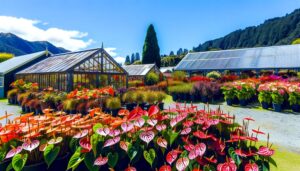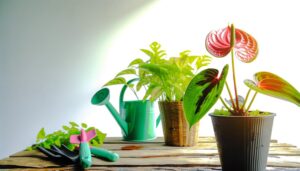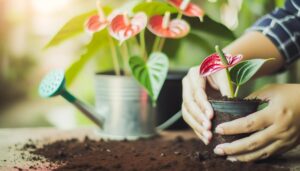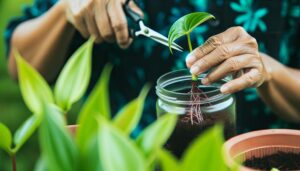Mastering Anthurium Draconopterum Care With a Step-By-Step Guide
To master Anthurium draconopterum care, place your plant in indirect sunlight, ideally near a north or east-facing window. Maintain humidity at 70-80% using a humidifier or water tray.
Water when the top inch of soil is dry, using distilled water. Opt for a well-draining potting mix of orchid bark, perlite, and peat moss, and make certain the pot has drainage holes.
Address yellowing leaves with nutrient adjustments and treat pest issues with insecticidal soap. Avoid overwatering to prevent root rot.
For more expert tips and detailed guidance, there's more to discover about perfecting your Anthurium draconopterum care routine.
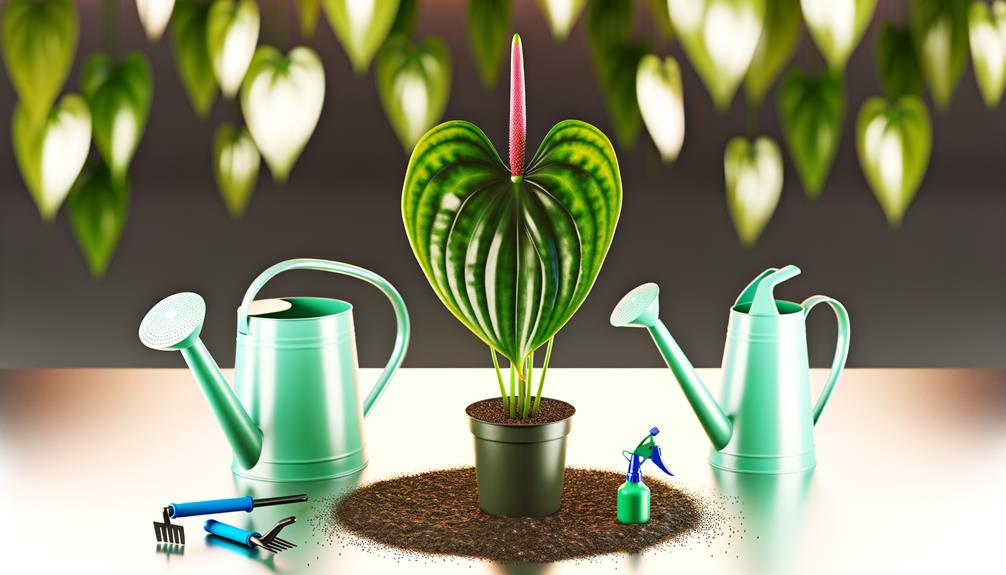
Key Takeaways
- Place Anthurium draconopterum near a north or east-facing window to ensure optimal indirect sunlight.
- Maintain 70-80% humidity using a humidifier or water tray to keep the plant healthy.
- Water with distilled water when the top inch of soil is dry, ensuring proper drainage.
- Use a well-draining potting mix with orchid bark, perlite, and peat moss for optimal soil conditions.
- Regularly inspect for yellowing leaves, root rot, and pests, addressing issues promptly with appropriate treatments.
Optimal Lighting Conditions
When providing ideal lighting conditions for Anthurium draconopterum, make certain it receives bright, indirect sunlight to mimic its natural understory habitat. Direct sunlight can scorch its delicate leaves, so position it near a north or east-facing window.
If natural light is inadequate, use artificial grow lights with a spectrum that replicates sunlight. Keep the light source about 12 inches away from the plant to avoid overheating.
Monitor the leaf color and growth; pale leaves indicate excessive light, while dark, slow-growing leaves suggest insufficient light. Rotate the plant periodically to ensure uniform light distribution.
Ideal Humidity Levels
Maintaining ideal humidity levels is essential for Anthurium draconopterum, as this tropical plant thrives in environments with 70-80% relative humidity. You should monitor humidity levels using a hygrometer. If your home's air is too dry, consider using a humidifier or placing a water tray nearby for evaporation. Grouping plants can also help increase humidity naturally. Ensure sufficient air circulation to prevent mold growth.
Here's a quick reference table to guide you:
| Humidity Level (%) | Effect on Plant | Recommended Action |
|---|---|---|
| Below 50% | Leaf browning, wilting | Use a humidifier |
| 50-70% | Suboptimal growth | Mist leaves, water tray |
| 70-80% | Optimal conditions | Maintain current methods |
Regularly check and adjust to keep your Anthurium draconopterum thriving.
Watering Techniques
Proper watering methods are crucial for the health of your Anthurium draconopterum, as both overwatering and underwatering can lead to serious issues. Aim to maintain consistent soil moisture without saturation.
Water your plant when the top inch of soil feels dry to the touch. Utilize room-temperature, distilled water to avoid chlorine and fluoride damage. Guarantee thorough watering until water drains from the pot's bottom, promoting root health. Never let the plant sit in standing water, which can trigger root rot.
Reduce watering frequency during winter dormancy. Monitor humidity and temperature fluctuations, as they directly impact water needs. Adopting a moisture meter can provide precise readings, ensuring ideal hydration and robust growth for your Anthurium draconopterum.
Soil and Potting
Fostering the health and growth of your Anthurium draconopterum relies on the right soil composition and potting methods. Begin with a well-draining potting mix, like a combination of orchid bark, perlite, and peat moss. This blend promotes excellent aeration and prevents waterlogging, which can cause root rot.
Select a pot with plenty of drainage holes to support excess water drainage. When transplanting, gently loosen the root ball and transfer the plant to a slightly larger container, ensuring it remains at the same depth as before. Avoid compressing the soil, as this can impede root oxygenation.
Regularly check for root-bound conditions and replant every 1-2 years to maintain strong growth and overall plant health.
Common Issues and Solutions
When caring for Anthurium draconopterum, you might encounter issues like yellowing leaves, root rot, or pest infestations, each requiring specific solutions to maintain best plant health.
Yellowing leaves often indicate nutrient deficiencies; consider using a balanced, water-soluble fertilizer.
Root rot results from overwatering; make sure your potting mix is well-draining and allow the soil to dry out between waterings.
For pest infestations, such as aphids or spider mites, use insecticidal soap or neem oil, applying thoroughly to affected areas.
Regularly inspect your plant for early signs of trouble and maintain ideal humidity and temperature conditions.
Addressing these issues promptly ensures your Anthurium draconopterum thrives, displaying its magnificent foliage.
Conclusion
To sum up, mastering Anthurium draconopterum care isn't just achievable; it's like wielding a green thumb of unmatched power.
By providing ideal lighting, maintaining perfect humidity levels, employing precise watering techniques, and using the right soil and potting methods, you'll transform into a botanical expert.
Remember, attentive care prevents common issues, ensuring your plant thrives.
With these tips, your Anthurium will flourish like a botanical masterpiece, showcasing your horticultural prowess.
Happy growing!


